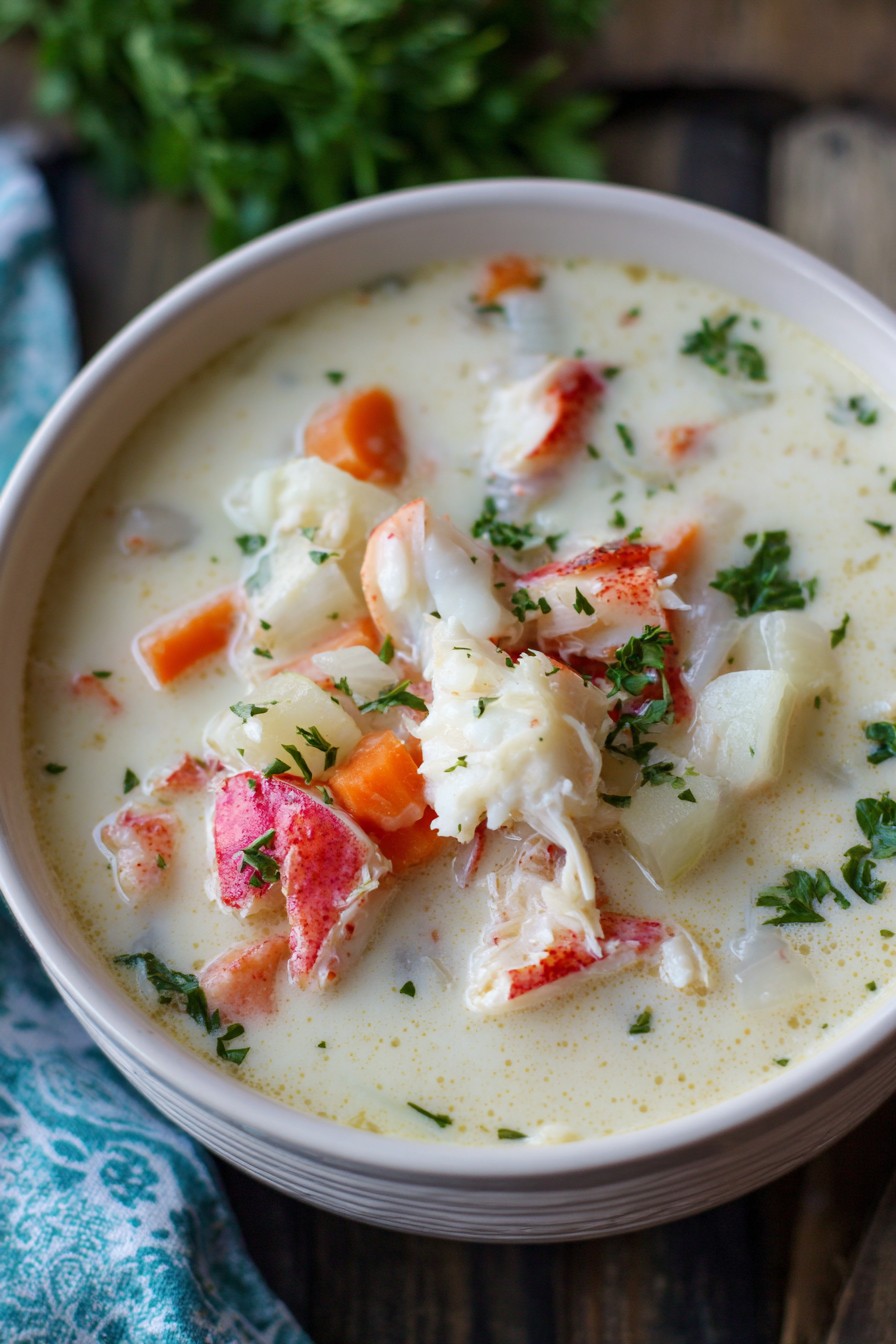Oceans of memories wash over me whenever I catch that first briny scent of crab soup simmering on the stove. Our family’s Maryland roots run deep as the Chesapeake Bay itself, and this soup was the centerpiece of every summer reunion, every holiday gathering, every time someone needed comforting. Opening that screen door to Grandma’s kitchen and being enveloped by that rich, savory aroma meant you were home, you were loved, and everything would be alright in this complicated world.
Why This Recipe Works
- The slow-simmered vegetable base creates layers of flavor that commercial broths simply can’t match, reminding me of how Grandma would always say good things take time, just like building family traditions
- Using both lump crab meat and crab claws gives you that perfect balance of tender morsels and rich, extracted flavor from the shells, much like how our family stories blend sweet memories with the harder lessons that made us stronger
- The careful addition of cream at the end prevents curdling while adding luxurious richness, a technique my mother taught me when I was just tall enough to see over the countertop
- Old Bay seasoning provides that authentic Chesapeake Bay flavor profile that transports me right back to childhood summers spent watching the boats come in
- The final sprinkle of fresh parsley and dash of sherry elevates this from simple soup to something truly special, just like how Grandma always made ordinary days feel extraordinary
Ingredients
- 1 pound fresh lump crab meat, picked over for shells
- 1 pound crab claws or bodies for stock
- 3 tablespoons unsalted butter
- 1 large yellow onion, finely diced
- 2 celery stalks, finely chopped
- 2 medium carrots, peeled and diced
- 3 cloves garlic, minced
- 1/4 cup all-purpose flour
- 6 cups seafood or chicken broth
- 1 cup heavy cream
- 2 teaspoons Old Bay seasoning
- 1 bay leaf
- 1/4 cup dry sherry
- 2 tablespoons fresh parsley, chopped
- Salt and freshly ground black pepper to taste
Equipment Needed
- Large heavy-bottomed stockpot or Dutch oven
- Wooden spoon
- Cutting board and sharp chef’s knife
- Measuring cups and spoons
- Fine mesh strainer
- Ladle
- Soup bowls for serving
Instructions

Preparing the Foundation
I always start this soup the way Grandma taught me – by melting the butter in my heaviest stockpot over medium heat until it foams gently, watching it carefully because burned butter can’t be saved, much like precious family moments. When the butter is ready, I add the diced onion, celery, and carrots, stirring them with my wooden spoon until they glisten with that golden butter coating. The kitchen fills with that magical aroma of cooking vegetables that takes me right back to standing on my tiptoes watching Grandma work her magic. I cook them slowly, stirring occasionally, for about 8-10 minutes until the onions turn translucent and the carrots begin to soften around the edges, but never letting them brown because patience yields the sweetest flavors. This slow cooking releases the natural sugars in the vegetables, creating the foundation that makes this soup taste like home.
Building the Flavor Base
Once the vegetables have softened properly, I add the minced garlic and cook for just one minute until fragrant, being careful not to let it burn because burned garlic turns bitter, much like unresolved family disagreements. Then I sprinkle the flour over the vegetables, stirring constantly to create a pale golden roux that will thicken our soup beautifully. I cook this mixture for about 2-3 minutes, until the raw flour taste disappears but before it takes on any color. Then I gradually pour in the broth while whisking constantly to prevent lumps from forming, watching as the mixture transforms from pasty to smoothly liquid. I add the crab claws or bodies, Old Bay seasoning, and that single bay leaf that always reminds me of Grandma saying “just one is enough – too much of anything spoils the magic.”
The Slow Simmer
This is where the magic happens – I bring the soup to a gentle boil, then immediately reduce the heat to low so it barely bubbles, covering the pot partially to allow some steam to escape. I let it simmer this way for 45 minutes, during which time I can almost hear Grandma humming in the kitchen as she used to do. The crab shells release their rich, briny essence into the broth, while the vegetables become meltingly tender and the flavors marry beautifully. I resist the temptation to stir too often, knowing that sometimes the best things develop when left undisturbed. After exactly 45 minutes, I remove the pot from heat and carefully strain the broth through a fine mesh strainer into a clean pot, pressing gently on the solids to extract every bit of flavor before discarding them.
Adding the Star Ingredient
Returning the strained broth to low heat, I now add the precious lump crab meat, handling it gently as Grandma always warned me that crab deserves respect. I stir it in carefully, trying to keep those beautiful lumps intact because finding those tender chunks in your spoon is part of the joy. Then I pour in the heavy cream slowly, stirring constantly as it incorporates into the golden broth, watching the color lighten to that perfect creamy bisque hue I remember from childhood. I heat it through for about 5-7 minutes, until it’s steaming hot but never boiling, because boiling would cause the cream to separate and we can’t have that. The soup should be thick enough to coat the back of a spoon but still flow gracefully.
Final Touches and Serving
Just before serving, I stir in the dry sherry – that secret ingredient Grandma always said “makes the flavors sing” – and season with salt and freshly ground black pepper to taste. I ladle the steaming soup into warmed bowls, remembering how Grandma would always warm the bowls in the oven first because she believed hot soup deserved a warm welcome. I sprinkle each serving with fresh chopped parsley for that pop of color and freshness, and if I’m feeling particularly nostalgic, I might add a tiny extra pinch of Old Bay on top. Serving it immediately while it’s piping hot ensures that first spoonful transports everyone right to the Chesapeake shoreline, just like it did for me all those years ago.
Tips and Tricks
Over the years, I’ve learned so many little secrets that make this crab soup truly exceptional. When selecting crab meat, always opt for fresh lump crab when possible – the sweet, tender chunks make all the difference, and if you can find jumbo lump, it’s worth the splurge for special occasions. If using canned crab, be sure to drain it well and pick through it carefully for any remaining shell fragments. When making the roux, the key is constant stirring and medium heat – too hot and it will brown, changing the flavor profile, too cool and it won’t cook out the raw flour taste properly. For the broth, if you have time to make your own seafood stock from shrimp shells or fish bones, it elevates the soup tremendously, but a good quality store-bought seafood or chicken broth works beautifully too. When adding the cream, always take the soup off direct heat and let it cool slightly before incorporating – this prevents curdling and ensures a silky smooth texture. If you need to reheat leftovers, do so gently over low heat, never boiling, and you may need to add a splash of broth or cream to restore the proper consistency. For freezing, it’s best to freeze before adding the cream, then add fresh cream when reheating. And remember – the sherry is non-negotiable in our family recipe, but if you must substitute, a good dry white wine works, though it won’t provide quite the same depth. Finally, always taste and adjust seasoning at the end, as the saltiness can vary depending on your broth and crab meat.
Recipe Variations
- For a Maryland-style crab soup, add 1 cup of corn kernels and 1 cup of lima beans during the last 15 minutes of cooking, along with a diced potato – this heartier version reminds me of the robust soups served at church suppers and community gatherings where everyone brought their best pot
- Create a spicy Creole version by adding 1/4 teaspoon of cayenne pepper, 1 chopped green bell pepper with the other vegetables, and substituting the Old Bay with Creole seasoning – this variation always makes me think of that summer we visited Louisiana relatives and discovered how different branches of the family put their own spin on coastal traditions
- For a richer bisque-style soup, puree the strained vegetables with a cup of the broth before adding the crab and cream – this creates that velvety texture that feels so luxurious and special, perfect for anniversary dinners or when you want to recreate that fancy restaurant feeling at home
- Make it dairy-free by substituting the heavy cream with coconut milk and using oil instead of butter – while it changes the flavor profile, it still captures that coastal essence and makes me appreciate how family recipes can adapt to changing times and needs while maintaining their soul
- Add 1/2 cup of converted rice during the last 20 minutes of simmering for a more substantial meal – this reminds me of how Grandma would stretch the soup when unexpected guests arrived, proving that hospitality matters more than perfection
Frequently Asked Questions
Can I use imitation crab meat instead of real crab?
While you technically can use imitation crab meat, I strongly recommend against it for this particular recipe. Imitation crab, typically made from white fish with added flavorings and colorings, simply doesn’t provide the same sweet, briny flavor or delicate texture that real crab meat offers. The soul of this soup comes from that authentic crab flavor that can’t be replicated. If budget is a concern, consider using a smaller amount of real crab meat and supplementing with additional vegetables or even some small shrimp. Remember, this soup is about capturing memories and traditions, and compromising on the main ingredient would be like telling only part of a family story – you might get the gist, but you’ll miss the heart and soul that makes it truly special.
How long will leftover crab soup keep in the refrigerator?
Properly stored in an airtight container, your crab soup will keep for 3-4 days in the refrigerator. I always let it cool completely before transferring it to containers, and I make sure to reheat it gently over low heat, never boiling, to maintain that creamy texture. If the soup seems too thick after refrigeration, you can thin it with a little additional broth or cream when reheating. Grandma always said soups taste better the next day anyway, as the flavors continue to meld and develop, much like family stories that grow richer with each retelling. Just be sure to give it a good stir when reheating and taste for seasoning, as flavors can change slightly when chilled.
Can I freeze this crab soup?
You can freeze this soup, but with some important considerations. It’s best to freeze it before adding the cream, as dairy-based soups can separate and become grainy when frozen and thawed. Prepare the soup through the straining step, then cool it completely and freeze in airtight containers for up to 3 months. When ready to serve, thaw overnight in the refrigerator, then reheat gently and add fresh cream along with the crab meat if you froze it without the crab. The texture and flavor should still be wonderful, though perhaps not quite as perfect as fresh. This freezing technique has saved me many times when I wanted to share this taste of home with friends moving away or family members who couldn’t make it to gatherings.
What can I serve with crab soup to make a complete meal?
This soup pairs beautifully with so many accompaniments that enhance the coastal experience. Crusty bread for dipping is essential – whether it’s a baguette, sourdough, or those little oyster crackers I loved as a child. A simple green salad with a light vinaigrette provides refreshing contrast to the rich soup. For a truly traditional Chesapeake meal, serve it with corn on the cob in summer or hush puppies any time of year. I often think about how Grandma would set the table with her blue-and-white striped cloth, the soup bowls waiting beside baskets of warm bread, creating that complete sensory experience that made ordinary dinners feel like celebrations of family and togetherness.
Summary
This crab soup recipe carries generations of coastal family memories in every spoonful, blending tender crab with slow-simmered vegetables and cream for that perfect taste of home and heritage that comforts and connects us across time and distance.
Grandma's Chesapeake Crab Soup
5
servings20
minutes1
minutesIngredients
Instructions
- 1 Melt butter in large stockpot over medium heat. Add onion, celery, and carrots, cooking 8-10 minutes until softened but not browned
- 2 Add garlic and cook 1 minute until fragrant. Sprinkle flour over vegetables and cook 2-3 minutes, stirring constantly
- 3 Gradually whisk in broth until smooth. Add crab claws, Old Bay, and bay leaf. Bring to boil then reduce to simmer for 45 minutes
- 4 Strain broth through fine mesh strainer into clean pot. Return to low heat and add lump crab meat
- 5 Stir in cream and heat through 5-7 minutes without boiling. Remove from heat, stir in sherry, and season with salt and pepper
- 6 Serve immediately garnished with fresh parsley



